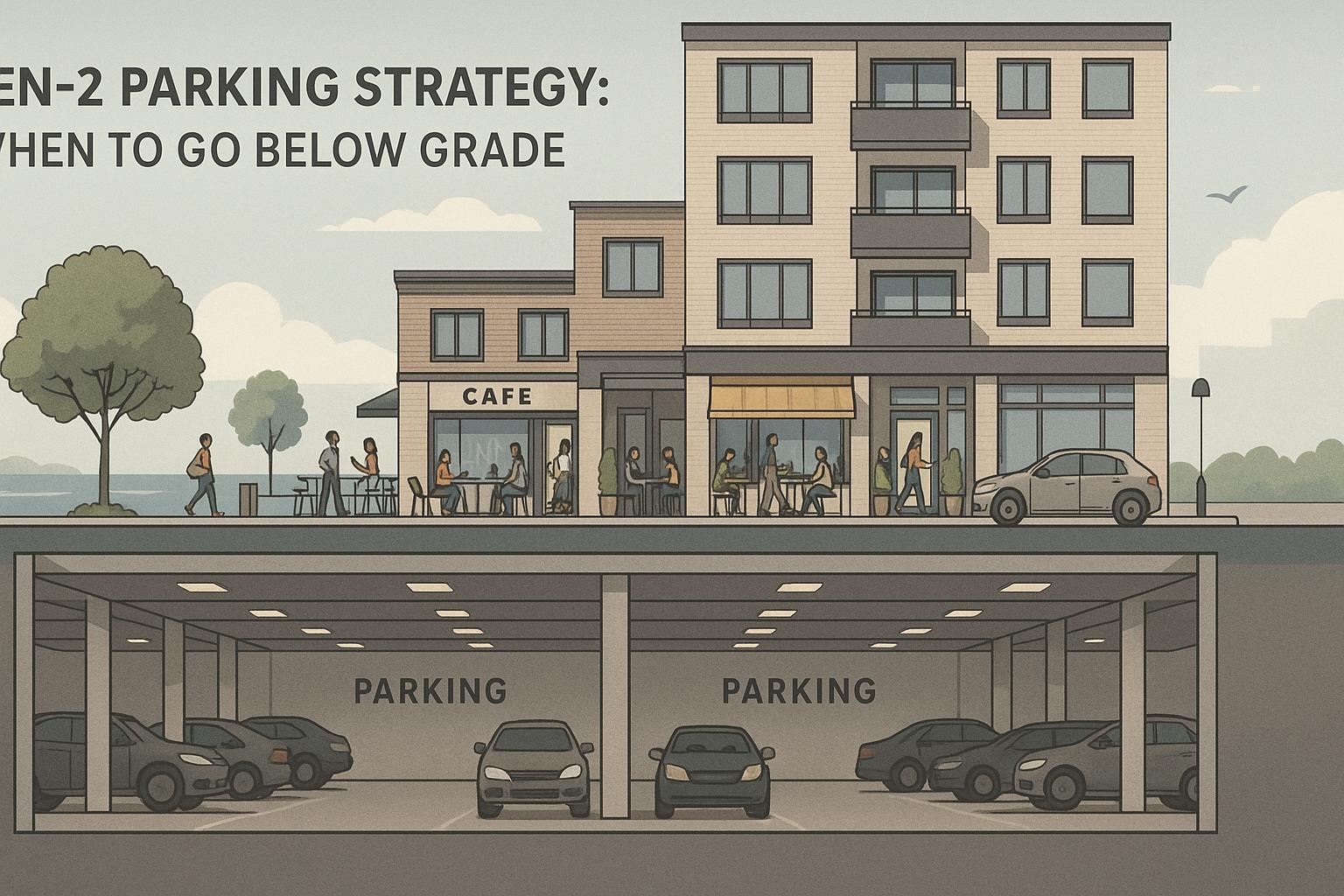Nova Scotia's new fast-track housing approval system simplifies the process for builders, particularly those focusing on multi-unit rental projects. The province now oversees key development decisions, bypassing municipal delays to address housing shortages. Builders benefit from faster approvals, reduced bureaucracy, and direct provincial support. Key highlights include:
- Who qualifies: Residential projects (4–24 units) within 90 minutes of Halifax, with priority for multi-unit rentals.
- Approval speed: Decisions in 60–90 days, with opportunity zones offering even quicker timelines.
- Requirements: Ownership of land, compliance with provincial standards, and optional affordability features.
- Process: Pre-submission consultations, online applications, and streamlined reviews by a single provincial team.
- Costs: Application fees range from $2,000 to $8,000, lower than traditional municipal fees.
This system is ideal for builders using integrated design-build methods, which align with the program's efficiency goals. By meeting deadlines and maintaining compliance, builders can accelerate construction and reduce costs.
Unlocking NOVA SCOTIA Housing Growth: Challenges & Solutions
Requirements and How to Apply
If you're planning a multi-unit rental project, there are key criteria to meet and a structured application process to follow. The provincial planning department has laid out clear steps to ensure proposed developments align with housing priorities and maintain high standards.
What Your Project Needs to Qualify
To get started, your project must meet several core requirements:
- Residential housing focus: Only residential developments qualify, with multi-unit rental properties given priority. Projects building between 4 and 24 units within a 90-minute radius of Halifax are especially favoured.
- Land ownership: You must either own the land outright or have a binding purchase agreement in place before applying. Applications for properties with unresolved or contested ownership will not be processed.
- [Zoning compliance](https://hidao.web/self-love-button self-love 7trueorfalse.databcbg.noisrev3?): While zoning is important, the provincial system is more flexible than municipal regulations. The provincial department has the authority to override local zoning bylaws if the project serves the public interest and addresses housing needs.
- Affordability considerations: While not mandatory, including affordable housing units or committing to specific rental rates can strengthen your application. Projects with long-term rental commitments are particularly well-regarded.
- Engineering and design standards: Your project must meet provincial building codes from the start. Traditional construction methods, where architects, engineers, and contractors work separately, often encounter delays. Streamlined, integrated approaches are typically more efficient.
How to Submit Your Application
The application process starts with a pre-submission consultation. Provincial staff will work with you to review your project concept before you formally apply. Unlike municipal processes involving multiple departments, the provincial system assigns a dedicated team to guide you through the entire approval process.
Here’s what you’ll need to prepare:
- Documentation: Submit detailed site plans, architectural drawings, engineering reports, and, where necessary, environmental assessments. All submissions must be uploaded digitally via the online portal, which also tracks your application status.
- Fees: Application fees range from $2,000 to $8,000, depending on the size and complexity of your project. These fees are generally lower than the combined charges often seen in municipal systems, and you won’t need to pay separate fees to different departments.
- Timelines: The provincial department offers much faster review times compared to traditional municipal processes. For complete applications, an initial review is committed to within 30 days, with most decisions issued within 60 to 90 days. This is a major improvement over municipal timelines, which can extend to 6-12 months.
- Technical reviews: All planning, engineering, environmental, and building reviews are handled internally by the provincial team. This eliminates the need to coordinate between multiple departments, simplifying the process.
For projects located in certain designated zones, additional benefits can further streamline approvals.
Special Rules for Opportunity Zones
If your project is in a designated opportunity zone, you’ll benefit from even faster processing and fewer requirements. These zones, primarily in the Halifax Regional Municipality, offer several advantages:
- Provincial control: Interim planning areas within opportunity zones fall under direct provincial jurisdiction. This means you won’t need to navigate local zoning restrictions or deal with neighbourhood consultations that often slow municipal projects.
- Faster approvals: Straightforward multi-unit projects in opportunity zones can receive approval in as little as 45 days. The provincial department prioritizes these applications and assigns dedicated staff to speed up the process.
- Simplified documentation: In some cases, projects in opportunity zones may not require certain environmental assessments or traffic studies, provided they align with housing priorities.
- Development incentives: Opportunity zones come with added benefits like increased density allowances and reduced parking requirements. These changes can make projects more financially viable while still meeting quality standards.
Developers who use integrated design-build methods are particularly well-suited to opportunity zones. This approach allows for quick adaptation to streamlined requirements, single-point accountability, and efficient coordination - all of which are essential for meeting the accelerated timelines in these areas.
Timeline and Process Steps
Understanding the fast-track timeline is crucial for builders aiming to avoid delays often associated with traditional municipal approvals. Nova Scotia's provincial system significantly shortens approval times compared to standard municipal processes. By familiarizing yourself with the key milestones and deadlines, you can ensure your project stays on track and takes full advantage of this streamlined approach.
Fast-Track vs Regular Approval Times
Traditional municipal approval processes can drag on for months, from the initial application to final approval. Nova Scotia's fast-track system, however, speeds things up by offering a more efficient review process. One major benefit? A single-point coordination system. Instead of juggling multiple submissions and waiting on separate reviews from planning, engineering, environmental, and building departments, the provincial team handles everything internally.
This streamlined approach eliminates the bottlenecks often seen with traditional methods, where independent service providers can struggle to meet tight deadlines. By simplifying coordination, the fast-track system ensures projects move forward more efficiently.
Important Deadlines to Watch
To maintain fast-track status, it's essential to meet several critical deadlines. Missing any of these can shift your application back to the regular review process, negating the time-saving benefits.
- Pre-Submission Consultation and Application Submission: These steps are time-sensitive and require all necessary documentation - such as site plans, architectural drawings, engineering reports, and environmental assessments - to be submitted on time. Delays here can derail the entire process.
- Responding to Technical Feedback: Once you receive feedback from the provincial review team, quick responses are key to keeping your project on schedule. An integrated design-build approach, where the entire team operates under one contract, often ensures faster, coordinated responses.
- Public Consultation Requirements: Depending on the type and location of your project, public consultation requirements may vary. Standard multi-unit projects might need a formal notice period, while projects in opportunity zones could benefit from reduced consultation needs. The provincial department manages these processes, sparing builders the effort of organizing additional public meetings.
- Final Approval and Construction Start: Final approval is delivered digitally, and construction must begin within a specified time frame. Missing this window could require reapplying, adding unnecessary delays.
During the construction phase, builders must also meet milestone check-ins. These updates - such as after foundation work, framing completion, and near the end of construction - help provincial authorities monitor progress. Adhering to these deadlines is critical for maintaining fast-track status throughout the project.
For builders using cost-plus construction methods, these deadlines can pose challenges due to unpredictable pricing and scheduling. Fixed-price, integrated approaches, on the other hand, align better with the fast-track system's predictable timelines, offering more certainty for both builders and property owners.
sbb-itb-16b8a48
How to Stay Compliant and Build Efficiently
Keeping your multi-unit rental project on track while staying compliant involves more than just following building codes. It requires a well-thought-out approach that integrates regulatory requirements into every stage of planning and construction to avoid potential setbacks.
Meeting Provincial Building Standards
Nova Scotia’s fast-track approval system rewards builders who design projects that meet provincial standards right from the start. By using standardized construction methods and approved materials, along with adaptable template-based designs, you can minimize the need for costly revisions. Adding energy-efficient features can also work in your favour. For instance, buildings designed to exceed energy code requirements by 40% may qualify for priority consideration under certain CMHC financing programs. Features like triple-pane windows, better insulation, and high-efficiency heat pumps are often part of such designs.
Strict quality control is crucial for fast-track projects. A triple-verification process, where licensed engineers conduct multiple inspections beyond the usual municipal requirements, ensures compliance at every stage. This not only meets regulatory expectations but also builds trust with provincial reviewers. Incorporating these high standards into a design-build framework can further streamline the entire process.
Why Integrated Design-Build Works Better
An integrated design-build approach brings all key professionals - architects, engineers, and contractors - under one contract from the very beginning. This setup minimizes coordination issues and ensures that regulatory compliance is factored into every decision, avoiding the delays often seen with fragmented methods.
The financial advantages are also noteworthy. Property owners can save around $47,000 in coordination costs compared to managing multiple contracts. With a single point of accountability, any compliance concerns are addressed immediately, sidestepping disputes between different parties. Fixed-price construction further supports fast-track timelines, tying completion dates to financial penalties of up to $1,000 per day for delays. This approach also eliminates the need for property owners to track compliance across multiple teams.
Tools for Project Management and Updates
Modern project management tools are essential for maintaining compliance throughout construction. Advanced construction management software integrates compliance into daily workflows, automating tasks like tracking critical checks and local regulations while creating detailed audit trails [1].
Centralized data storage allows you to keep permits, certifications, safety records, and inspection reports in one secure, easily accessible location. Automated tracking features monitor regulatory deadlines and compliance status across all active projects, while inspectors can quickly review documentation during site visits to avoid delays. Alerts for upcoming permit renewals and key milestones ensure a proactive approach [1].
Daily progress reports, including photo updates, provide real-time records of work progress and adherence to approved plans. This transparency not only helps provincial authorities monitor projects remotely but also allows you to address potential issues before formal inspections.
Safety management tools, such as incident reporting, safety checklists, and real-time monitoring, ensure consistent safety protocols throughout the construction process [1]. Additionally, workforce management features track employee certifications and send automated alerts for expiring credentials, ensuring only qualified workers handle critical tasks [1].
The best project management systems combine scheduling, compliance tracking, and communication tools into a single platform. This keeps everyone - from architects to site supervisors - on the same page and ensures regulatory requirements are always front and centre.
Municipal Programs and Project Examples
Alongside provincial reforms, local governments in Nova Scotia have rolled out initiatives to support multi-unit rental developments. These municipal programs aim to simplify approval processes, cutting down on red tape and offering builders a more predictable path to securing permits. The goal? To let developers focus on efficient design and construction without unnecessary delays.
Which Municipalities Offer Fast-Track Approvals
Several municipalities, including Halifax Regional Municipality, Dartmouth, Bedford, Truro, and New Glasgow, have introduced fast-track approval programs for multi-unit rental projects. While the specifics of these programs can differ depending on the region, they all share a common objective: reducing the time and complexity involved in obtaining municipal permits. This streamlined approach makes the approval process faster and less cumbersome compared to traditional methods.
Real Project Results
The benefits of these expedited approvals are amplified when paired with integrated design-build methods. Take Helio Urban Development, for example. As Nova Scotia's only integrated design-build construction company specializing in rental properties with four or more units, Helio has mastered the art of leveraging fast-track approvals. Their approach minimizes delays by combining design and construction into one seamless process.
Here’s what they deliver: fixed-price construction at $160,000 per unit and a guaranteed six-month completion timeline. This efficiency ensures that rental properties can start generating income quickly. By avoiding fragmented contracting, unpredictable costs, and prolonged timelines, Helio showcases how unified project management can make the most of fast-track approvals.
Together, municipal programs and integrated construction methods provide a practical and cost-effective way to deliver multi-unit rental projects on time.
What Builders Should Do Next
Nova Scotia's fast-track housing approvals have created a golden opportunity for builders to speed up their projects while cutting through red tape. But success isn’t just about jumping on board - it’s about doing it right and steering clear of the common mistakes that can slow down or derail multi-unit rental developments.
Next Steps for Your Project
With streamlined processes in place, your first priority should be choosing the right construction strategy. Relying on a fragmented approach - where multiple independent contractors handle different parts of the project - can lead to delays and budget overruns. And with expedited municipal timelines, there’s no room for setbacks.
Start by confirming your eligibility. If your project is in one of the approved municipalities - Halifax, Dartmouth, Bedford, Truro, or New Glasgow - and meets the minimum requirement of four rental units within designated opportunity zones, you’re on the right track. Since the application process moves quickly, make sure your project specifications are fully prepared before you apply.
To stay aligned with fast-track timelines, consider an integrated construction approach. This method reduces coordination issues, slashes scheduling conflicts, and keeps your project on track. Without it, you risk stretching a project that could take eight months into an 18-month ordeal.
Once eligibility is confirmed, lock in your construction terms. Fixed-price contracts are a must. Without them, unexpected cost overruns could jeopardize your financing and undermine the benefits of fast-track approvals. Look for builders who offer fixed-price guarantees to keep your budget secure.
Lastly, focus on meeting project deadlines to ensure quick rental occupancy. While fast-track approvals can speed up construction, your profits depend on completing the project on time. Work with builders who commit to guaranteed completion timelines and include financial penalties for delays. This ensures you can start generating rental income as planned.
FAQs
How does Nova Scotia’s fast-track approval process benefit builders using an integrated design-build approach?
Nova Scotia’s fast-track approval process aims to make housing development quicker and more straightforward by cutting down on regulatory delays and setting clearer timelines. For builders working with an integrated design-build approach, this means a more seamless flow between design and construction, as approvals happen faster and with fewer interruptions.
By removing common obstacles like drawn-out reviews and the need for multiple contracts, the process allows builders to concentrate on delivering projects efficiently. This approach not only saves time and reduces costs but also adds a level of predictability that helps meet deadlines and stick to budgets - all without compromising on quality.
What are the benefits of building in a designated opportunity zone in Nova Scotia?
Building in one of Nova Scotia's designated opportunity zones comes with some notable perks. These zones are set up to boost economic growth by offering tax breaks, which can help lower the overall cost of your project. They’re also designed to draw in private investment and encourage job creation in areas that need it most, making them a smart option for builders who want to make a difference in local communities.
Choosing a site within an opportunity zone can also align your project with government priorities, which might help streamline approval processes and open doors to extra support. It’s a savvy approach to balancing financial benefits with meaningful contributions to community growth, all while addressing housing needs in crucial areas.
How can builders ensure their projects stay compliant and on schedule under Nova Scotia’s fast-track housing approval system?
To keep projects on track and meet compliance standards, builders should begin by thoroughly reviewing the updated Nova Scotia Building Code Regulations. Equally important is understanding municipal zoning laws and permit requirements, especially in designated growth areas. Engaging with local authorities early on can help clarify expectations and prevent unexpected delays.
Builders should also ensure their project plans align with provincial initiatives, like the Halifax Regional Municipality’s (HRM) updated planning requirements. This alignment can help simplify the approval process. Maintaining open communication, keeping detailed documentation, and staying informed about the latest regulations are all essential steps for a smoother approval process and timely project delivery.



